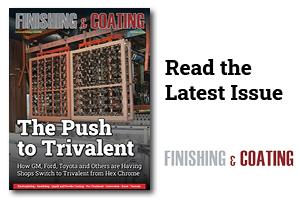A jobs shop specializing in zinc plating contacted me about a recent and somewhat strange issue has arisen with one of our customers.
 Frank AltmayerThe client believed that there were “whiskers” growing on their zinc plating, and the shop was a bit perplexed. They sent me some samples and I took a look.
Frank AltmayerThe client believed that there were “whiskers” growing on their zinc plating, and the shop was a bit perplexed. They sent me some samples and I took a look.
Whiskers on electroplated components are definitely no joke, and it appears that whiskers on zinc electroplate is a hot topic much as tin whiskers were a hot topic several decades ago. It seems that some clean rooms in the electronics industry were constructed with flooring panels and superstructure that was electrogalvanized, a term for zinc plating that is typically thicker than 0.0005 in.
Over a few years, it was discovered that the zinc plating on the floor panels grew whiskers that were typically 2 microns in diameter and several millimeters long. When disturbed, the whiskers were dispersed into the air and the clean room was no longer “clean.” The airborne whiskers could contaminate sensitive electrical devices and cause short circuits.
Over the past 50 years, there have been numerous articles written on the subject of whisker growth. My friend, Dick Baker, MSF, (R. G. Baker, Consultants, Inc.) is an expert on the subject. Here is what I have gleaned and distilled from Dick, NASA and numerous articles on the subject:
Zinc Whiskers
 Nodules produced by welding.Zinc whiskers have always been around, but are only now becoming a “hot topic” due to the development of electronics that operate at very low voltages. At high voltages, the whiskers are vaporized, but at low voltages they cause shorts or voltage fluctuations.
Nodules produced by welding.Zinc whiskers have always been around, but are only now becoming a “hot topic” due to the development of electronics that operate at very low voltages. At high voltages, the whiskers are vaporized, but at low voltages they cause shorts or voltage fluctuations.
Tin, zinc, cadmium, indium, and antimony are metals known to grow whiskers under special conditions. Explanations of the mechanism for such growth vary, but in general the following conditions make whisker growth more likely:
- A deposit containing a high amount of residual stress is more likely to produce whiskers than a semi-bright or dull deposit. In general, plating solutions that contain higher concentrations of organics, organic by-products and heavy metal contamination will produce a more stressed deposit, as organics tend to incorporate carbon into the zinc deposit. For zinc plating, cyanide chemistries produce zinc deposits with the least amount of carbon content.
- Application of compressive external stresses to the plated component.
- A large difference between the coefficient of thermal expansion between the plated deposit and the substrate.
Whisker growth may be initiated in a matter of days or years. Growth rates of 0.03-0.09 mm/yr have been reported for tin deposits. Zinc whiskers can grow at rates up to 250 microns (0.01 in.) per year and have been reported as long as 1 cm (0.4”). The zinc whiskers typically form a basket-weave pattern (see photo)
The literature does not agree on conditions that enhance or inhibit whisker growth. Temperatures ranging from room to 122ºF (50ºC) have been reported as optimum (for tin), while it is agreed that temperatures exceeding 150ºC inhibit growth (probably due to stress relief). Thermal cycling is reported to accelerate growth or have no effect, depending on which article you read. Humidity is reported as accelerating growth or having no effect. Electrolytic fields can cause whiskers to grow in altered directions.
Researchers tend to agree that one way to avoid/inhibit the formation of whiskers is to plate an alloy instead of the pure metal. In the case of tin, reflowing eliminates the problem, but no such relief is available for zinc. The whiskers do not grow on all zinc plated surfaces (why this is the case is not fully understood at this time).
Zinc whiskers appear to be limited to electroplated deposits. No reports of whisker growth on hot dip zinc have been made to date.
 Typical zinc whiskers.As for the parts I was sent meupon visual examination, the protrusions that the client thinks might be whiskers are actually nodules that were produced by the resistance welding process, which tended to splatter metal and produce protrusions. The size, location and geometry of these nodules indicate this is a welding condition, not zinc whiskers. For reference, see the photo of typical zinc whiskers.
Typical zinc whiskers.As for the parts I was sent meupon visual examination, the protrusions that the client thinks might be whiskers are actually nodules that were produced by the resistance welding process, which tended to splatter metal and produce protrusions. The size, location and geometry of these nodules indicate this is a welding condition, not zinc whiskers. For reference, see the photo of typical zinc whiskers.
You might want to look over some of the references/websites below as well.
My thanks to Dick Baker for providing some of the articles referenced.
Frank Altmayer is a Master Surface Finisher, an AESF Fellow, and the technical education director of the AESF Foundation and NASF. He owned Scientific Control Laboratories from 1986 to 2007 and has over 50 years of experience in metal finishing. He received the AESF Past Presidents Award, NAMF Award of Special Recognition, AESF Leadership Award, AESF Fellowship Award, Chicago Branch AESF Geldzahler Service Award, and NASF Award of Special Recognition.
Bibliography
R. G. Baker, “The Real World of Corrosion, Spontaneous Metallic Whisker Growth,” P&SF, 74, No. 10, 10 (1987)
R. G. Baker, “The Real World of Corrosion, Conclusion: Whisker Growth”, P&SF, 74, No. 11, 12 (1987)
S. M. Arnold, “The Growth and Properties of Metal Whiskers,” Tech Proc. 43rd Annual Convention of AES (1956)
J. R. Downs, “The Phenomenon of Zinc Whisker Growth and the Rotary Switch,” Metal Finishing, August, 1994, p. 23
D. Loman, “How Do Zinc Whiskers Affect Todayʼs Data Centers?” Power Quality Assurance, January, 2001, p. 32
www.nepp.nasa.gov/whisker/background/ www.wes.net/crs-zinc_whisker_detail.htm www.chipcenter.com/eexpert/lgoldberg2/
wtrumble002.html www.finishing.com/0000-0199/020.html www.accessfloors.com.au/zincwhiskers.htm



































